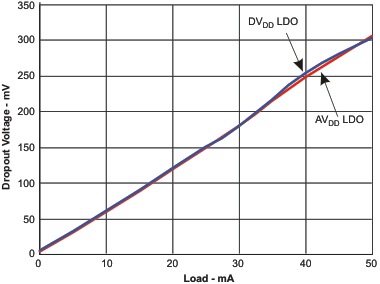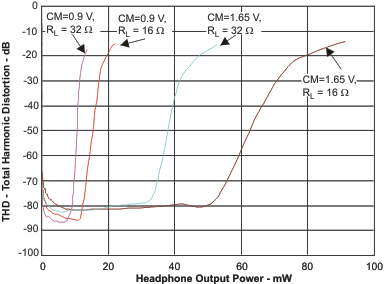SLOS602E September 2008 – September 2019 TLV320AIC3204
PRODUCTION DATA.
- 1 Features
- 2 Applications
- 3 Description
- 4 Revision History
- 5 Device Comparison Table
- 6 Pin Configuration and Functions
-
7 Specifications
- 7.1 Absolute Maximum Ratings
- 7.2 ESD Ratings
- 7.3 Recommended Operating Conditions
- 7.4 Thermal Information
- 7.5 Electrical Characteristics, ADC
- 7.6 Electrical Characteristics, Bypass Outputs
- 7.7 Electrical Characteristics, Microphone Interface
- 7.8 Electrical Characteristics, Audio DAC Outputs
- 7.9 Electrical Characteristics, LDO
- 7.10 Electrical Characteristics, Misc.
- 7.11 Electrical Characteristics, Logic Levels
- 7.12 I2S LJF and RJF Timing in Master Mode (see )
- 7.13 I2S LJF and RJF Timing in Slave Mode (see )
- 7.14 DSP Timing in Master Mode (see )
- 7.15 DSP Timing in Slave Mode (see )
- 7.16 Digital Microphone PDM Timing (see )
- 7.17 I2C Interface Timing
- 7.18 SPI Interface Timing (See )
- 7.19 Typical Characteristics
- 7.20 Typical Characteristics, FFT
- 8 Parameter Measurement Information
- 9 Detailed Description
- 10Application and Implementation
- 11Power Supply Recommendations
- 12Layout
- 13Device and Documentation Support
- 14Mechanical, Packaging, and Orderable Information
Package Options
Mechanical Data (Package|Pins)
- RHB|32
Thermal pad, mechanical data (Package|Pins)
- RHB|32
Orderable Information
7.19 Typical Characteristics
 Figure 10. Total Harmonic Distortion vs Headphone Output Power
Figure 10. Total Harmonic Distortion vs Headphone Output Power  Figure 12. LDO Dropout Voltage vs Load Current
Figure 12. LDO Dropout Voltage vs Load Current 
| CM = 0.9 V |
 Figure 9. Total Harmonic Distortion vs Headphone Output Power
Figure 9. Total Harmonic Distortion vs Headphone Output Power  Figure 11. Headphone SNR and Output Power vs Output Common Mode Setting
Figure 11. Headphone SNR and Output Power vs Output Common Mode Setting  Figure 13. LDO Load Response
Figure 13. LDO Load Response 